Safety Concerns in Aviation: The Impact of Technology Over-Reliance
VerifiedAdded on 2023/01/23
|25
|6616
|77
Report
AI Summary
This report examines the safety implications of technology over-reliance in the aviation industry. It begins by outlining the evolution of pilot roles from manual control to system monitoring, highlighting the potential for increased risks. The report investigates how automation impacts pilot skills, decision-making, and workload, drawing on literature reviews and data from the U.S. National Transportation Safety Board. It explores the causes of accidents linked to technology failures, including inappropriate feedback and user interface issues, and discusses the importance of pilot training in mitigating these risks. The report concludes with recommendations to address the problems of over-reliance and improve overall aviation safety, emphasizing the need for a balanced approach between automation and human expertise.
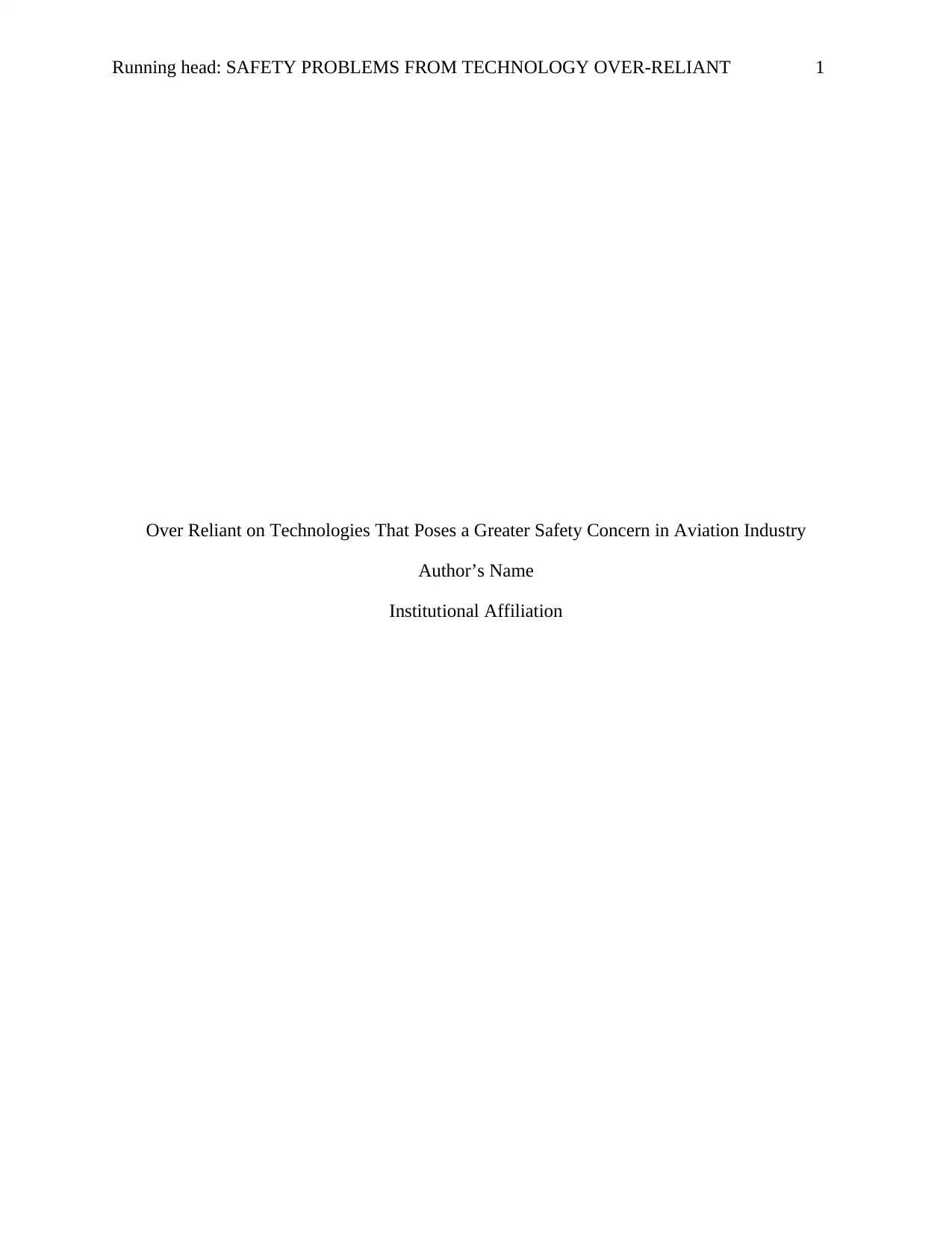
Running head: SAFETY PROBLEMS FROM TECHNOLOGY OVER-RELIANT 1
Over Reliant on Technologies That Poses a Greater Safety Concern in Aviation Industry
Author’s Name
Institutional Affiliation
Over Reliant on Technologies That Poses a Greater Safety Concern in Aviation Industry
Author’s Name
Institutional Affiliation
Paraphrase This Document
Need a fresh take? Get an instant paraphrase of this document with our AI Paraphraser
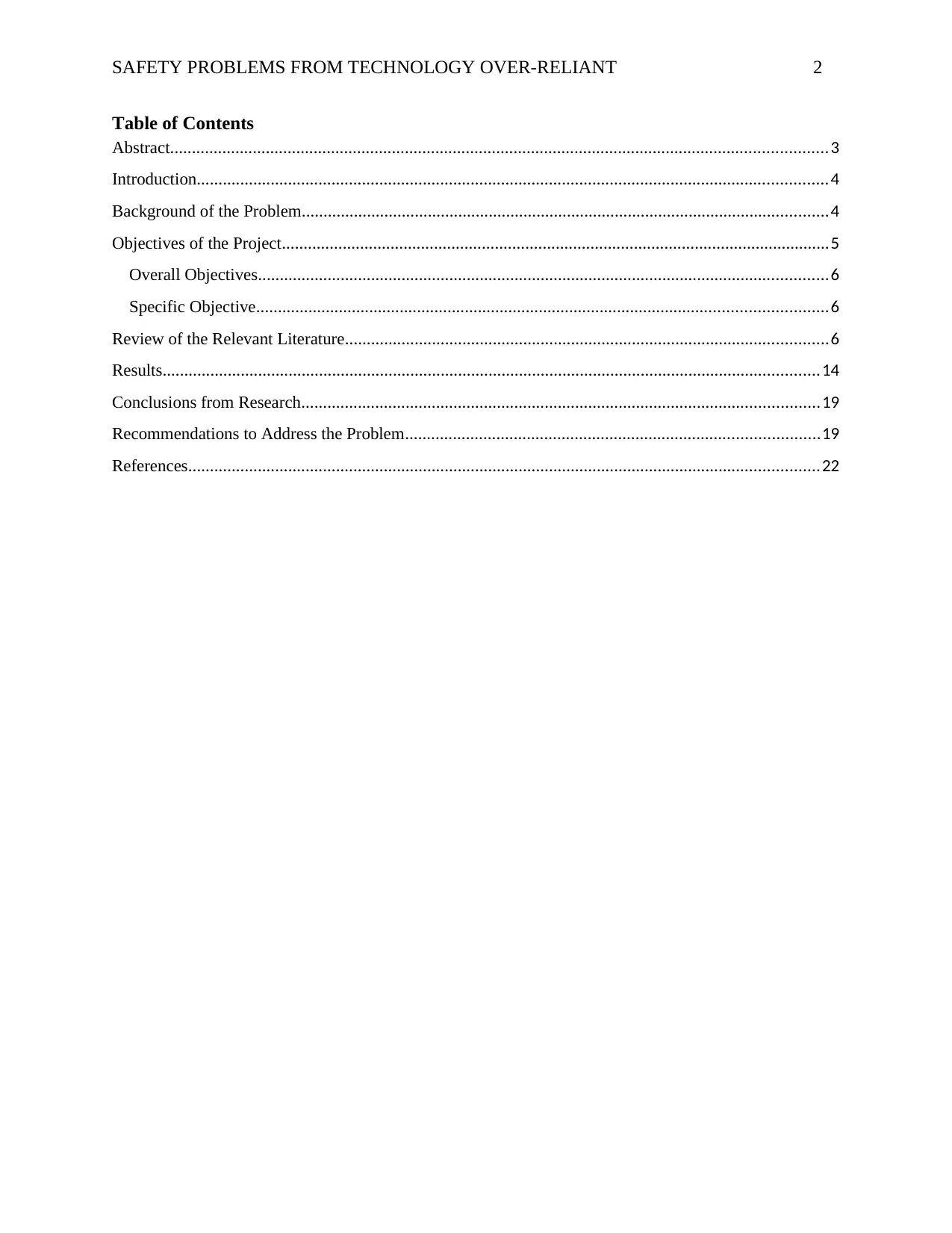
SAFETY PROBLEMS FROM TECHNOLOGY OVER-RELIANT 2
Table of Contents
Abstract.......................................................................................................................................................3
Introduction.................................................................................................................................................4
Background of the Problem.........................................................................................................................4
Objectives of the Project..............................................................................................................................5
Overall Objectives...................................................................................................................................6
Specific Objective...................................................................................................................................6
Review of the Relevant Literature...............................................................................................................6
Results.......................................................................................................................................................14
Conclusions from Research.......................................................................................................................19
Recommendations to Address the Problem...............................................................................................19
References.................................................................................................................................................22
Table of Contents
Abstract.......................................................................................................................................................3
Introduction.................................................................................................................................................4
Background of the Problem.........................................................................................................................4
Objectives of the Project..............................................................................................................................5
Overall Objectives...................................................................................................................................6
Specific Objective...................................................................................................................................6
Review of the Relevant Literature...............................................................................................................6
Results.......................................................................................................................................................14
Conclusions from Research.......................................................................................................................19
Recommendations to Address the Problem...............................................................................................19
References.................................................................................................................................................22
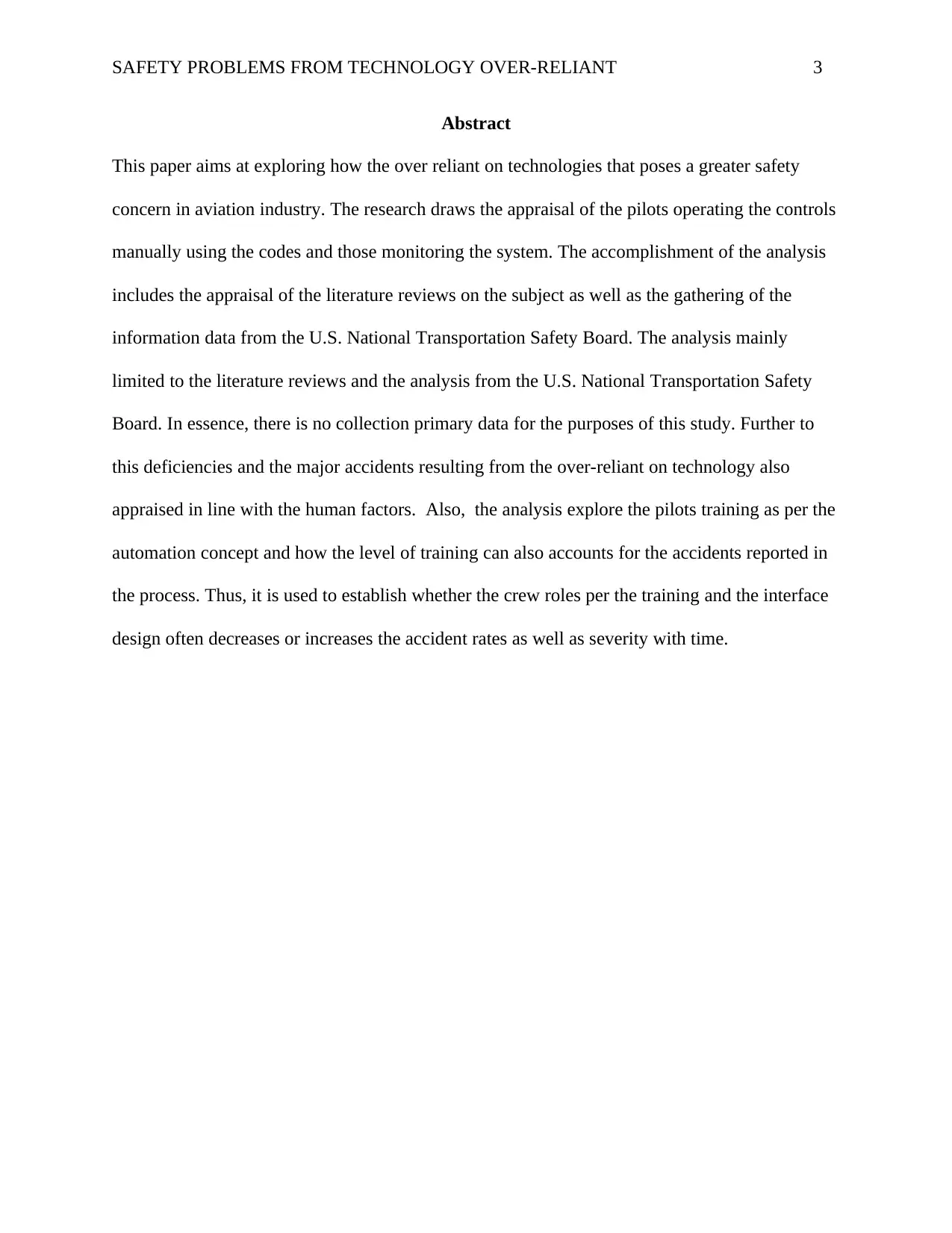
SAFETY PROBLEMS FROM TECHNOLOGY OVER-RELIANT 3
Abstract
This paper aims at exploring how the over reliant on technologies that poses a greater safety
concern in aviation industry. The research draws the appraisal of the pilots operating the controls
manually using the codes and those monitoring the system. The accomplishment of the analysis
includes the appraisal of the literature reviews on the subject as well as the gathering of the
information data from the U.S. National Transportation Safety Board. The analysis mainly
limited to the literature reviews and the analysis from the U.S. National Transportation Safety
Board. In essence, there is no collection primary data for the purposes of this study. Further to
this deficiencies and the major accidents resulting from the over-reliant on technology also
appraised in line with the human factors. Also, the analysis explore the pilots training as per the
automation concept and how the level of training can also accounts for the accidents reported in
the process. Thus, it is used to establish whether the crew roles per the training and the interface
design often decreases or increases the accident rates as well as severity with time.
Abstract
This paper aims at exploring how the over reliant on technologies that poses a greater safety
concern in aviation industry. The research draws the appraisal of the pilots operating the controls
manually using the codes and those monitoring the system. The accomplishment of the analysis
includes the appraisal of the literature reviews on the subject as well as the gathering of the
information data from the U.S. National Transportation Safety Board. The analysis mainly
limited to the literature reviews and the analysis from the U.S. National Transportation Safety
Board. In essence, there is no collection primary data for the purposes of this study. Further to
this deficiencies and the major accidents resulting from the over-reliant on technology also
appraised in line with the human factors. Also, the analysis explore the pilots training as per the
automation concept and how the level of training can also accounts for the accidents reported in
the process. Thus, it is used to establish whether the crew roles per the training and the interface
design often decreases or increases the accident rates as well as severity with time.
⊘ This is a preview!⊘
Do you want full access?
Subscribe today to unlock all pages.

Trusted by 1+ million students worldwide
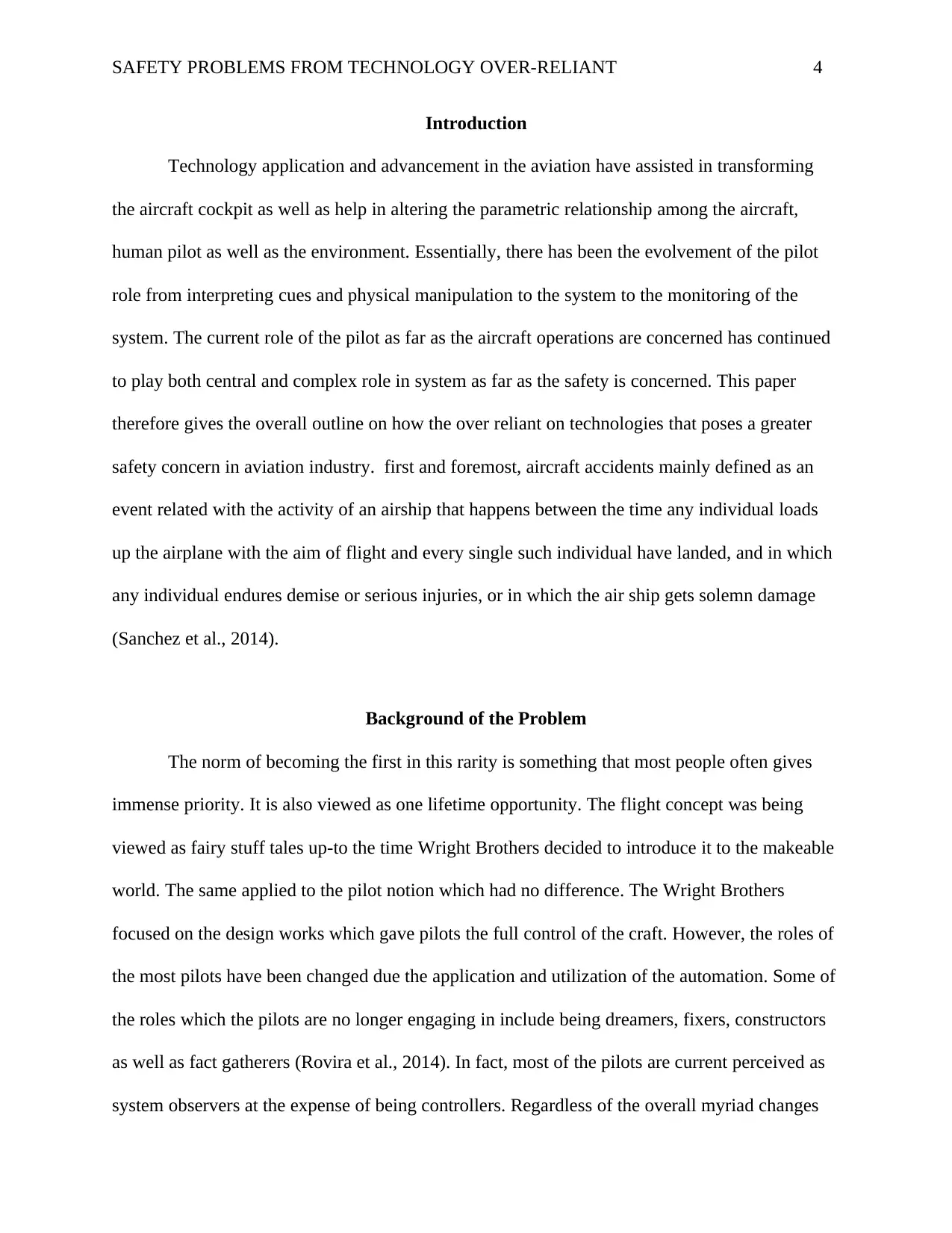
SAFETY PROBLEMS FROM TECHNOLOGY OVER-RELIANT 4
Introduction
Technology application and advancement in the aviation have assisted in transforming
the aircraft cockpit as well as help in altering the parametric relationship among the aircraft,
human pilot as well as the environment. Essentially, there has been the evolvement of the pilot
role from interpreting cues and physical manipulation to the system to the monitoring of the
system. The current role of the pilot as far as the aircraft operations are concerned has continued
to play both central and complex role in system as far as the safety is concerned. This paper
therefore gives the overall outline on how the over reliant on technologies that poses a greater
safety concern in aviation industry. first and foremost, aircraft accidents mainly defined as an
event related with the activity of an airship that happens between the time any individual loads
up the airplane with the aim of flight and every single such individual have landed, and in which
any individual endures demise or serious injuries, or in which the air ship gets solemn damage
(Sanchez et al., 2014).
Background of the Problem
The norm of becoming the first in this rarity is something that most people often gives
immense priority. It is also viewed as one lifetime opportunity. The flight concept was being
viewed as fairy stuff tales up-to the time Wright Brothers decided to introduce it to the makeable
world. The same applied to the pilot notion which had no difference. The Wright Brothers
focused on the design works which gave pilots the full control of the craft. However, the roles of
the most pilots have been changed due the application and utilization of the automation. Some of
the roles which the pilots are no longer engaging in include being dreamers, fixers, constructors
as well as fact gatherers (Rovira et al., 2014). In fact, most of the pilots are current perceived as
system observers at the expense of being controllers. Regardless of the overall myriad changes
Introduction
Technology application and advancement in the aviation have assisted in transforming
the aircraft cockpit as well as help in altering the parametric relationship among the aircraft,
human pilot as well as the environment. Essentially, there has been the evolvement of the pilot
role from interpreting cues and physical manipulation to the system to the monitoring of the
system. The current role of the pilot as far as the aircraft operations are concerned has continued
to play both central and complex role in system as far as the safety is concerned. This paper
therefore gives the overall outline on how the over reliant on technologies that poses a greater
safety concern in aviation industry. first and foremost, aircraft accidents mainly defined as an
event related with the activity of an airship that happens between the time any individual loads
up the airplane with the aim of flight and every single such individual have landed, and in which
any individual endures demise or serious injuries, or in which the air ship gets solemn damage
(Sanchez et al., 2014).
Background of the Problem
The norm of becoming the first in this rarity is something that most people often gives
immense priority. It is also viewed as one lifetime opportunity. The flight concept was being
viewed as fairy stuff tales up-to the time Wright Brothers decided to introduce it to the makeable
world. The same applied to the pilot notion which had no difference. The Wright Brothers
focused on the design works which gave pilots the full control of the craft. However, the roles of
the most pilots have been changed due the application and utilization of the automation. Some of
the roles which the pilots are no longer engaging in include being dreamers, fixers, constructors
as well as fact gatherers (Rovira et al., 2014). In fact, most of the pilots are current perceived as
system observers at the expense of being controllers. Regardless of the overall myriad changes
Paraphrase This Document
Need a fresh take? Get an instant paraphrase of this document with our AI Paraphraser
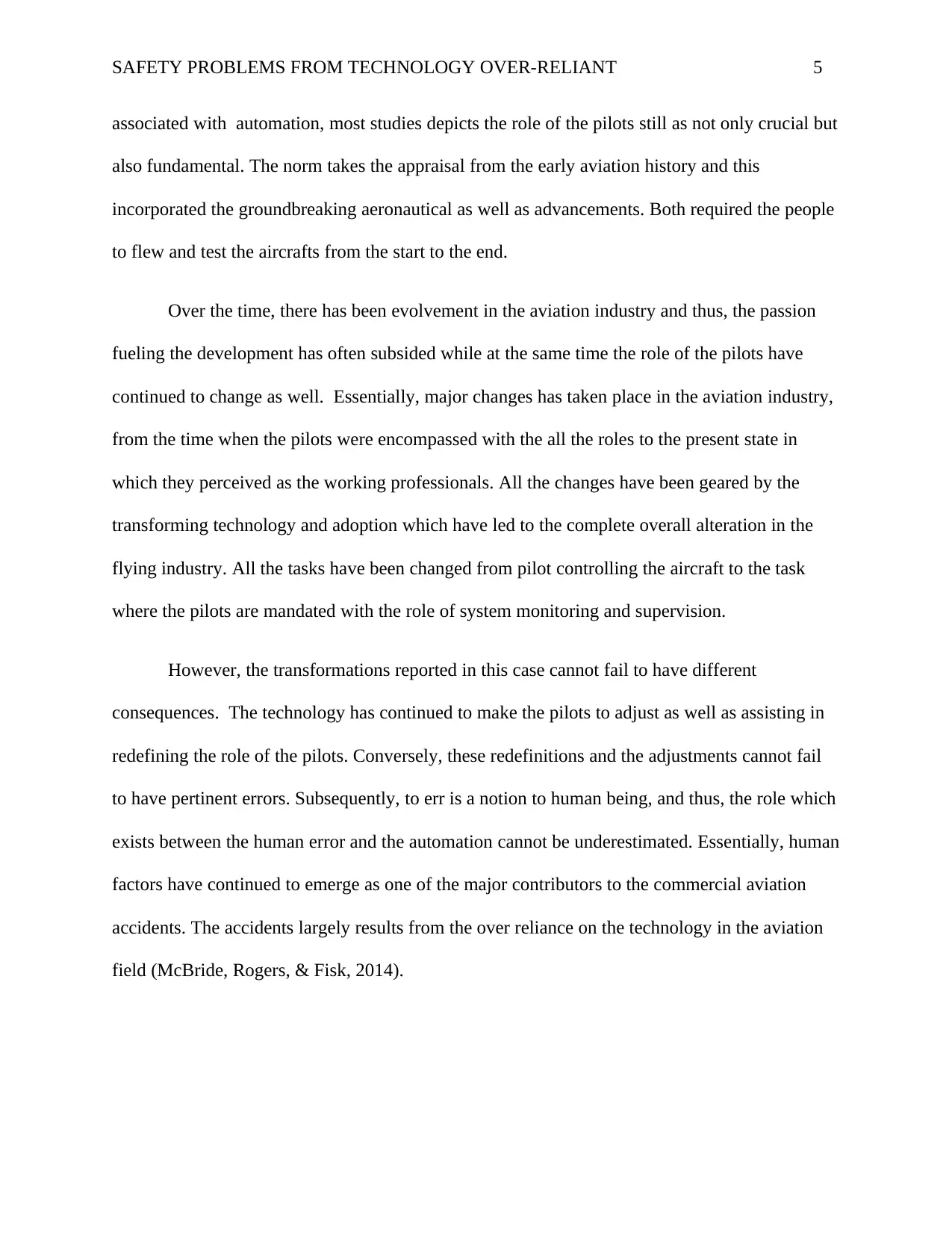
SAFETY PROBLEMS FROM TECHNOLOGY OVER-RELIANT 5
associated with automation, most studies depicts the role of the pilots still as not only crucial but
also fundamental. The norm takes the appraisal from the early aviation history and this
incorporated the groundbreaking aeronautical as well as advancements. Both required the people
to flew and test the aircrafts from the start to the end.
Over the time, there has been evolvement in the aviation industry and thus, the passion
fueling the development has often subsided while at the same time the role of the pilots have
continued to change as well. Essentially, major changes has taken place in the aviation industry,
from the time when the pilots were encompassed with the all the roles to the present state in
which they perceived as the working professionals. All the changes have been geared by the
transforming technology and adoption which have led to the complete overall alteration in the
flying industry. All the tasks have been changed from pilot controlling the aircraft to the task
where the pilots are mandated with the role of system monitoring and supervision.
However, the transformations reported in this case cannot fail to have different
consequences. The technology has continued to make the pilots to adjust as well as assisting in
redefining the role of the pilots. Conversely, these redefinitions and the adjustments cannot fail
to have pertinent errors. Subsequently, to err is a notion to human being, and thus, the role which
exists between the human error and the automation cannot be underestimated. Essentially, human
factors have continued to emerge as one of the major contributors to the commercial aviation
accidents. The accidents largely results from the over reliance on the technology in the aviation
field (McBride, Rogers, & Fisk, 2014).
associated with automation, most studies depicts the role of the pilots still as not only crucial but
also fundamental. The norm takes the appraisal from the early aviation history and this
incorporated the groundbreaking aeronautical as well as advancements. Both required the people
to flew and test the aircrafts from the start to the end.
Over the time, there has been evolvement in the aviation industry and thus, the passion
fueling the development has often subsided while at the same time the role of the pilots have
continued to change as well. Essentially, major changes has taken place in the aviation industry,
from the time when the pilots were encompassed with the all the roles to the present state in
which they perceived as the working professionals. All the changes have been geared by the
transforming technology and adoption which have led to the complete overall alteration in the
flying industry. All the tasks have been changed from pilot controlling the aircraft to the task
where the pilots are mandated with the role of system monitoring and supervision.
However, the transformations reported in this case cannot fail to have different
consequences. The technology has continued to make the pilots to adjust as well as assisting in
redefining the role of the pilots. Conversely, these redefinitions and the adjustments cannot fail
to have pertinent errors. Subsequently, to err is a notion to human being, and thus, the role which
exists between the human error and the automation cannot be underestimated. Essentially, human
factors have continued to emerge as one of the major contributors to the commercial aviation
accidents. The accidents largely results from the over reliance on the technology in the aviation
field (McBride, Rogers, & Fisk, 2014).
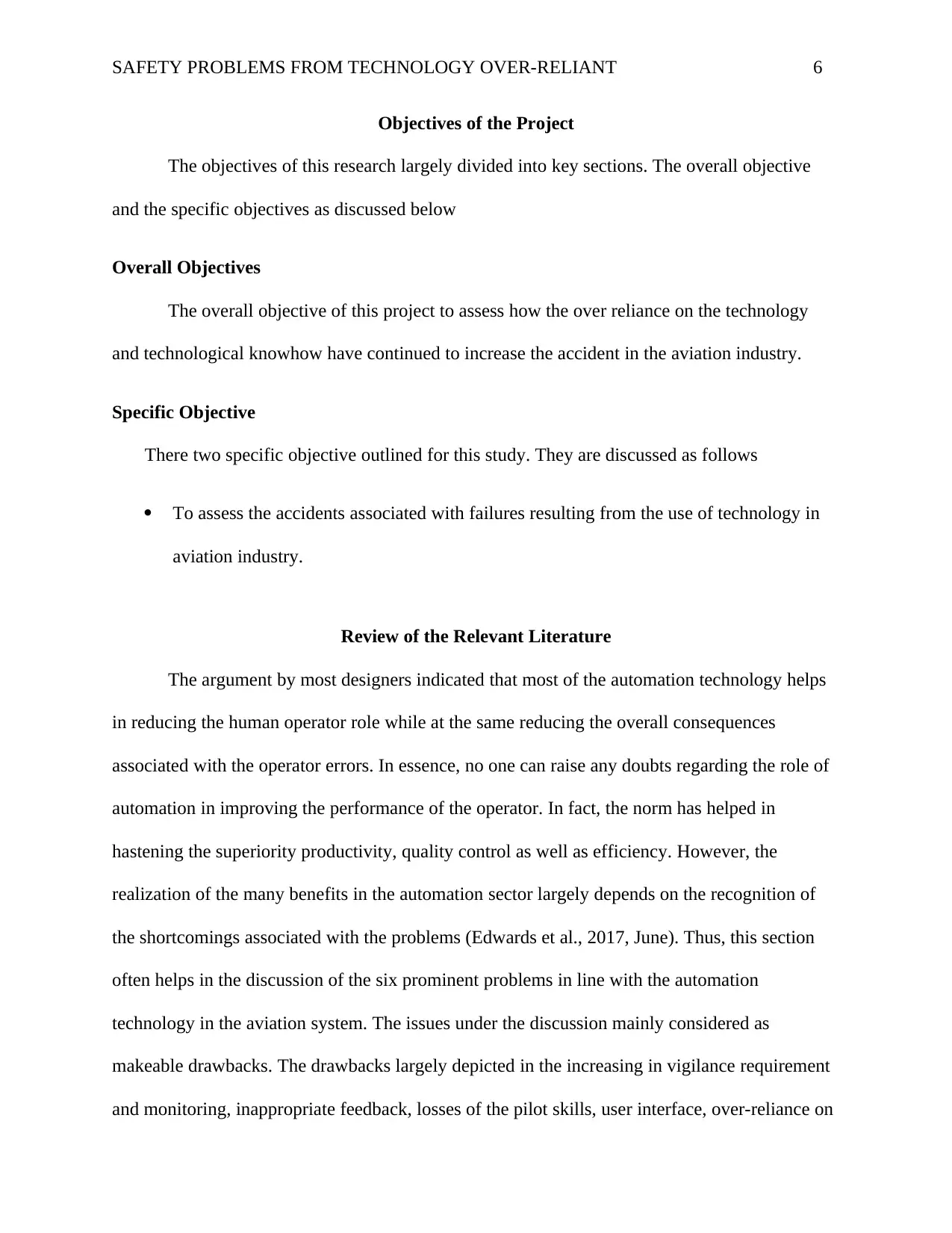
SAFETY PROBLEMS FROM TECHNOLOGY OVER-RELIANT 6
Objectives of the Project
The objectives of this research largely divided into key sections. The overall objective
and the specific objectives as discussed below
Overall Objectives
The overall objective of this project to assess how the over reliance on the technology
and technological knowhow have continued to increase the accident in the aviation industry.
Specific Objective
There two specific objective outlined for this study. They are discussed as follows
To assess the accidents associated with failures resulting from the use of technology in
aviation industry.
Review of the Relevant Literature
The argument by most designers indicated that most of the automation technology helps
in reducing the human operator role while at the same reducing the overall consequences
associated with the operator errors. In essence, no one can raise any doubts regarding the role of
automation in improving the performance of the operator. In fact, the norm has helped in
hastening the superiority productivity, quality control as well as efficiency. However, the
realization of the many benefits in the automation sector largely depends on the recognition of
the shortcomings associated with the problems (Edwards et al., 2017, June). Thus, this section
often helps in the discussion of the six prominent problems in line with the automation
technology in the aviation system. The issues under the discussion mainly considered as
makeable drawbacks. The drawbacks largely depicted in the increasing in vigilance requirement
and monitoring, inappropriate feedback, losses of the pilot skills, user interface, over-reliance on
Objectives of the Project
The objectives of this research largely divided into key sections. The overall objective
and the specific objectives as discussed below
Overall Objectives
The overall objective of this project to assess how the over reliance on the technology
and technological knowhow have continued to increase the accident in the aviation industry.
Specific Objective
There two specific objective outlined for this study. They are discussed as follows
To assess the accidents associated with failures resulting from the use of technology in
aviation industry.
Review of the Relevant Literature
The argument by most designers indicated that most of the automation technology helps
in reducing the human operator role while at the same reducing the overall consequences
associated with the operator errors. In essence, no one can raise any doubts regarding the role of
automation in improving the performance of the operator. In fact, the norm has helped in
hastening the superiority productivity, quality control as well as efficiency. However, the
realization of the many benefits in the automation sector largely depends on the recognition of
the shortcomings associated with the problems (Edwards et al., 2017, June). Thus, this section
often helps in the discussion of the six prominent problems in line with the automation
technology in the aviation system. The issues under the discussion mainly considered as
makeable drawbacks. The drawbacks largely depicted in the increasing in vigilance requirement
and monitoring, inappropriate feedback, losses of the pilot skills, user interface, over-reliance on
⊘ This is a preview!⊘
Do you want full access?
Subscribe today to unlock all pages.

Trusted by 1+ million students worldwide
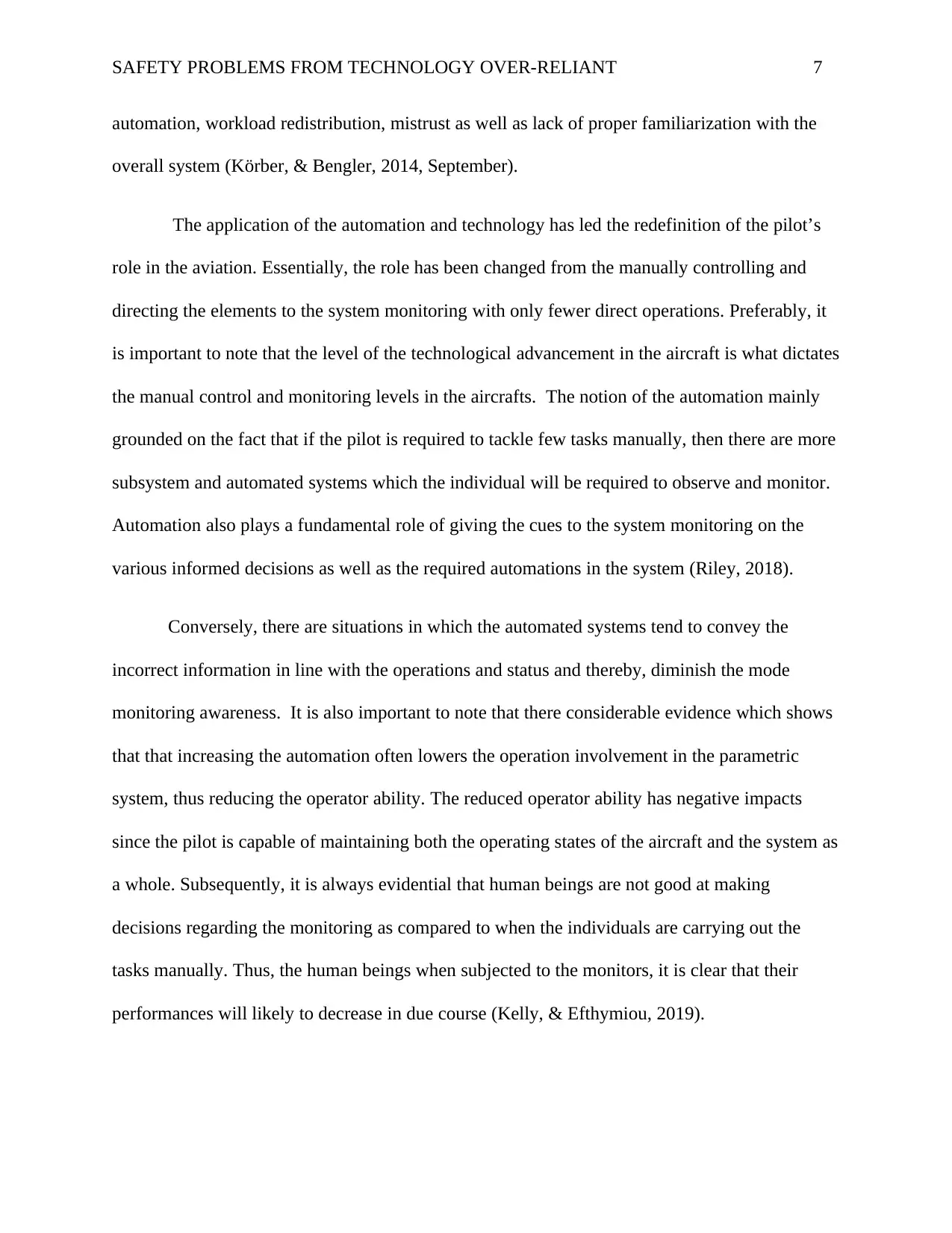
SAFETY PROBLEMS FROM TECHNOLOGY OVER-RELIANT 7
automation, workload redistribution, mistrust as well as lack of proper familiarization with the
overall system (Körber, & Bengler, 2014, September).
The application of the automation and technology has led the redefinition of the pilot’s
role in the aviation. Essentially, the role has been changed from the manually controlling and
directing the elements to the system monitoring with only fewer direct operations. Preferably, it
is important to note that the level of the technological advancement in the aircraft is what dictates
the manual control and monitoring levels in the aircrafts. The notion of the automation mainly
grounded on the fact that if the pilot is required to tackle few tasks manually, then there are more
subsystem and automated systems which the individual will be required to observe and monitor.
Automation also plays a fundamental role of giving the cues to the system monitoring on the
various informed decisions as well as the required automations in the system (Riley, 2018).
Conversely, there are situations in which the automated systems tend to convey the
incorrect information in line with the operations and status and thereby, diminish the mode
monitoring awareness. It is also important to note that there considerable evidence which shows
that that increasing the automation often lowers the operation involvement in the parametric
system, thus reducing the operator ability. The reduced operator ability has negative impacts
since the pilot is capable of maintaining both the operating states of the aircraft and the system as
a whole. Subsequently, it is always evidential that human beings are not good at making
decisions regarding the monitoring as compared to when the individuals are carrying out the
tasks manually. Thus, the human beings when subjected to the monitors, it is clear that their
performances will likely to decrease in due course (Kelly, & Efthymiou, 2019).
automation, workload redistribution, mistrust as well as lack of proper familiarization with the
overall system (Körber, & Bengler, 2014, September).
The application of the automation and technology has led the redefinition of the pilot’s
role in the aviation. Essentially, the role has been changed from the manually controlling and
directing the elements to the system monitoring with only fewer direct operations. Preferably, it
is important to note that the level of the technological advancement in the aircraft is what dictates
the manual control and monitoring levels in the aircrafts. The notion of the automation mainly
grounded on the fact that if the pilot is required to tackle few tasks manually, then there are more
subsystem and automated systems which the individual will be required to observe and monitor.
Automation also plays a fundamental role of giving the cues to the system monitoring on the
various informed decisions as well as the required automations in the system (Riley, 2018).
Conversely, there are situations in which the automated systems tend to convey the
incorrect information in line with the operations and status and thereby, diminish the mode
monitoring awareness. It is also important to note that there considerable evidence which shows
that that increasing the automation often lowers the operation involvement in the parametric
system, thus reducing the operator ability. The reduced operator ability has negative impacts
since the pilot is capable of maintaining both the operating states of the aircraft and the system as
a whole. Subsequently, it is always evidential that human beings are not good at making
decisions regarding the monitoring as compared to when the individuals are carrying out the
tasks manually. Thus, the human beings when subjected to the monitors, it is clear that their
performances will likely to decrease in due course (Kelly, & Efthymiou, 2019).
Paraphrase This Document
Need a fresh take? Get an instant paraphrase of this document with our AI Paraphraser
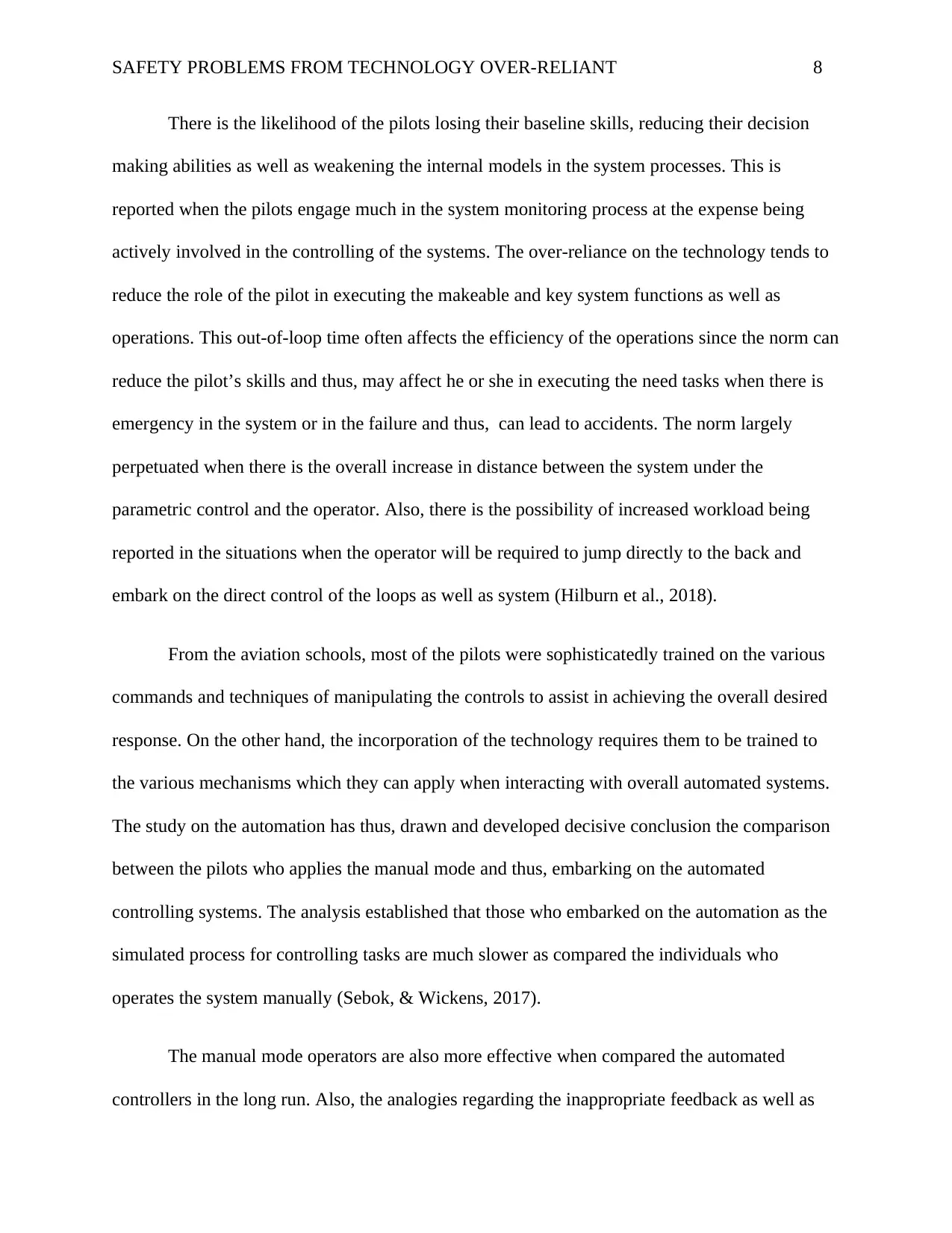
SAFETY PROBLEMS FROM TECHNOLOGY OVER-RELIANT 8
There is the likelihood of the pilots losing their baseline skills, reducing their decision
making abilities as well as weakening the internal models in the system processes. This is
reported when the pilots engage much in the system monitoring process at the expense being
actively involved in the controlling of the systems. The over-reliance on the technology tends to
reduce the role of the pilot in executing the makeable and key system functions as well as
operations. This out-of-loop time often affects the efficiency of the operations since the norm can
reduce the pilot’s skills and thus, may affect he or she in executing the need tasks when there is
emergency in the system or in the failure and thus, can lead to accidents. The norm largely
perpetuated when there is the overall increase in distance between the system under the
parametric control and the operator. Also, there is the possibility of increased workload being
reported in the situations when the operator will be required to jump directly to the back and
embark on the direct control of the loops as well as system (Hilburn et al., 2018).
From the aviation schools, most of the pilots were sophisticatedly trained on the various
commands and techniques of manipulating the controls to assist in achieving the overall desired
response. On the other hand, the incorporation of the technology requires them to be trained to
the various mechanisms which they can apply when interacting with overall automated systems.
The study on the automation has thus, drawn and developed decisive conclusion the comparison
between the pilots who applies the manual mode and thus, embarking on the automated
controlling systems. The analysis established that those who embarked on the automation as the
simulated process for controlling tasks are much slower as compared the individuals who
operates the system manually (Sebok, & Wickens, 2017).
The manual mode operators are also more effective when compared the automated
controllers in the long run. Also, the analogies regarding the inappropriate feedback as well as
There is the likelihood of the pilots losing their baseline skills, reducing their decision
making abilities as well as weakening the internal models in the system processes. This is
reported when the pilots engage much in the system monitoring process at the expense being
actively involved in the controlling of the systems. The over-reliance on the technology tends to
reduce the role of the pilot in executing the makeable and key system functions as well as
operations. This out-of-loop time often affects the efficiency of the operations since the norm can
reduce the pilot’s skills and thus, may affect he or she in executing the need tasks when there is
emergency in the system or in the failure and thus, can lead to accidents. The norm largely
perpetuated when there is the overall increase in distance between the system under the
parametric control and the operator. Also, there is the possibility of increased workload being
reported in the situations when the operator will be required to jump directly to the back and
embark on the direct control of the loops as well as system (Hilburn et al., 2018).
From the aviation schools, most of the pilots were sophisticatedly trained on the various
commands and techniques of manipulating the controls to assist in achieving the overall desired
response. On the other hand, the incorporation of the technology requires them to be trained to
the various mechanisms which they can apply when interacting with overall automated systems.
The study on the automation has thus, drawn and developed decisive conclusion the comparison
between the pilots who applies the manual mode and thus, embarking on the automated
controlling systems. The analysis established that those who embarked on the automation as the
simulated process for controlling tasks are much slower as compared the individuals who
operates the system manually (Sebok, & Wickens, 2017).
The manual mode operators are also more effective when compared the automated
controllers in the long run. Also, the analogies regarding the inappropriate feedback as well as
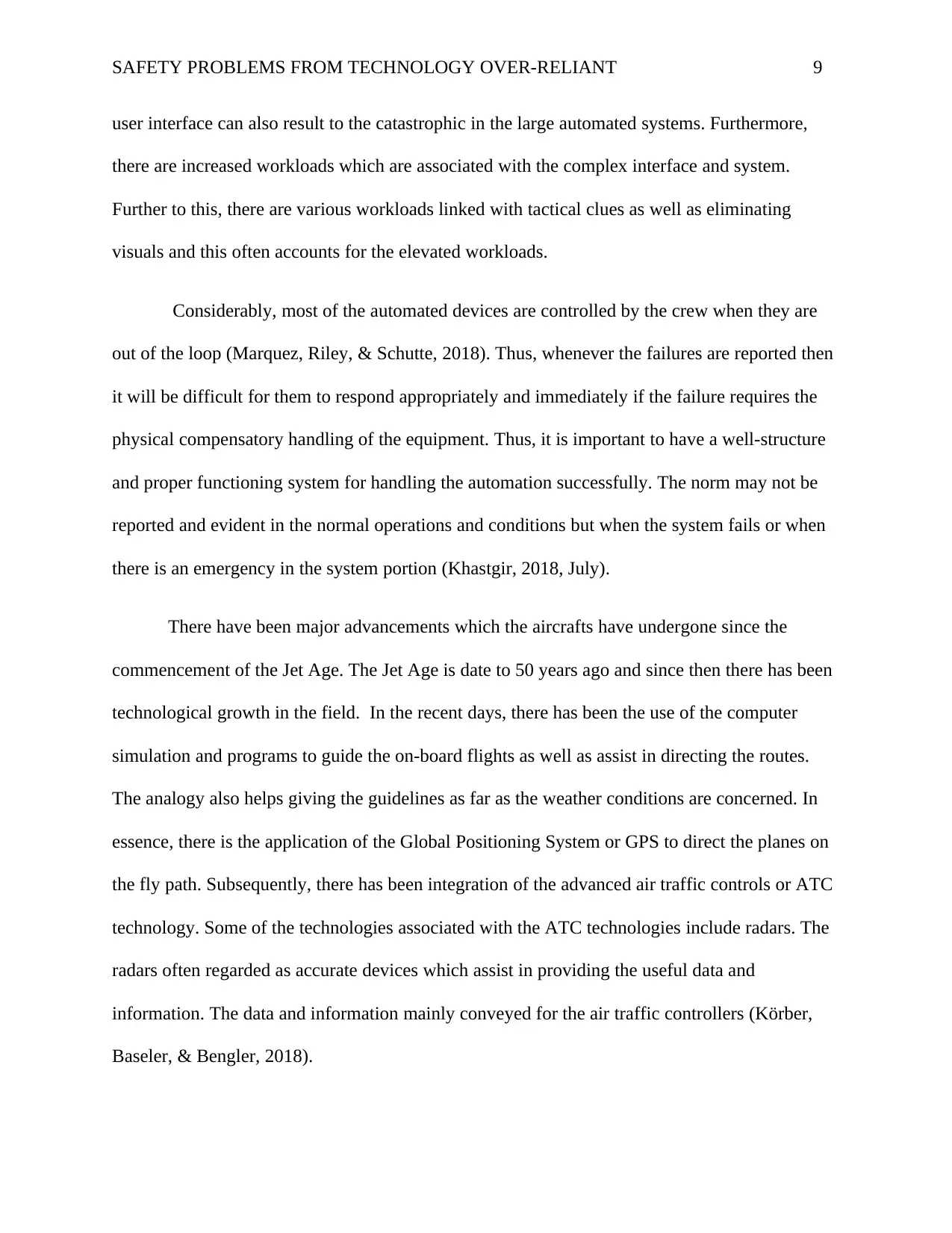
SAFETY PROBLEMS FROM TECHNOLOGY OVER-RELIANT 9
user interface can also result to the catastrophic in the large automated systems. Furthermore,
there are increased workloads which are associated with the complex interface and system.
Further to this, there are various workloads linked with tactical clues as well as eliminating
visuals and this often accounts for the elevated workloads.
Considerably, most of the automated devices are controlled by the crew when they are
out of the loop (Marquez, Riley, & Schutte, 2018). Thus, whenever the failures are reported then
it will be difficult for them to respond appropriately and immediately if the failure requires the
physical compensatory handling of the equipment. Thus, it is important to have a well-structure
and proper functioning system for handling the automation successfully. The norm may not be
reported and evident in the normal operations and conditions but when the system fails or when
there is an emergency in the system portion (Khastgir, 2018, July).
There have been major advancements which the aircrafts have undergone since the
commencement of the Jet Age. The Jet Age is date to 50 years ago and since then there has been
technological growth in the field. In the recent days, there has been the use of the computer
simulation and programs to guide the on-board flights as well as assist in directing the routes.
The analogy also helps giving the guidelines as far as the weather conditions are concerned. In
essence, there is the application of the Global Positioning System or GPS to direct the planes on
the fly path. Subsequently, there has been integration of the advanced air traffic controls or ATC
technology. Some of the technologies associated with the ATC technologies include radars. The
radars often regarded as accurate devices which assist in providing the useful data and
information. The data and information mainly conveyed for the air traffic controllers (Körber,
Baseler, & Bengler, 2018).
user interface can also result to the catastrophic in the large automated systems. Furthermore,
there are increased workloads which are associated with the complex interface and system.
Further to this, there are various workloads linked with tactical clues as well as eliminating
visuals and this often accounts for the elevated workloads.
Considerably, most of the automated devices are controlled by the crew when they are
out of the loop (Marquez, Riley, & Schutte, 2018). Thus, whenever the failures are reported then
it will be difficult for them to respond appropriately and immediately if the failure requires the
physical compensatory handling of the equipment. Thus, it is important to have a well-structure
and proper functioning system for handling the automation successfully. The norm may not be
reported and evident in the normal operations and conditions but when the system fails or when
there is an emergency in the system portion (Khastgir, 2018, July).
There have been major advancements which the aircrafts have undergone since the
commencement of the Jet Age. The Jet Age is date to 50 years ago and since then there has been
technological growth in the field. In the recent days, there has been the use of the computer
simulation and programs to guide the on-board flights as well as assist in directing the routes.
The analogy also helps giving the guidelines as far as the weather conditions are concerned. In
essence, there is the application of the Global Positioning System or GPS to direct the planes on
the fly path. Subsequently, there has been integration of the advanced air traffic controls or ATC
technology. Some of the technologies associated with the ATC technologies include radars. The
radars often regarded as accurate devices which assist in providing the useful data and
information. The data and information mainly conveyed for the air traffic controllers (Körber,
Baseler, & Bengler, 2018).
⊘ This is a preview!⊘
Do you want full access?
Subscribe today to unlock all pages.

Trusted by 1+ million students worldwide
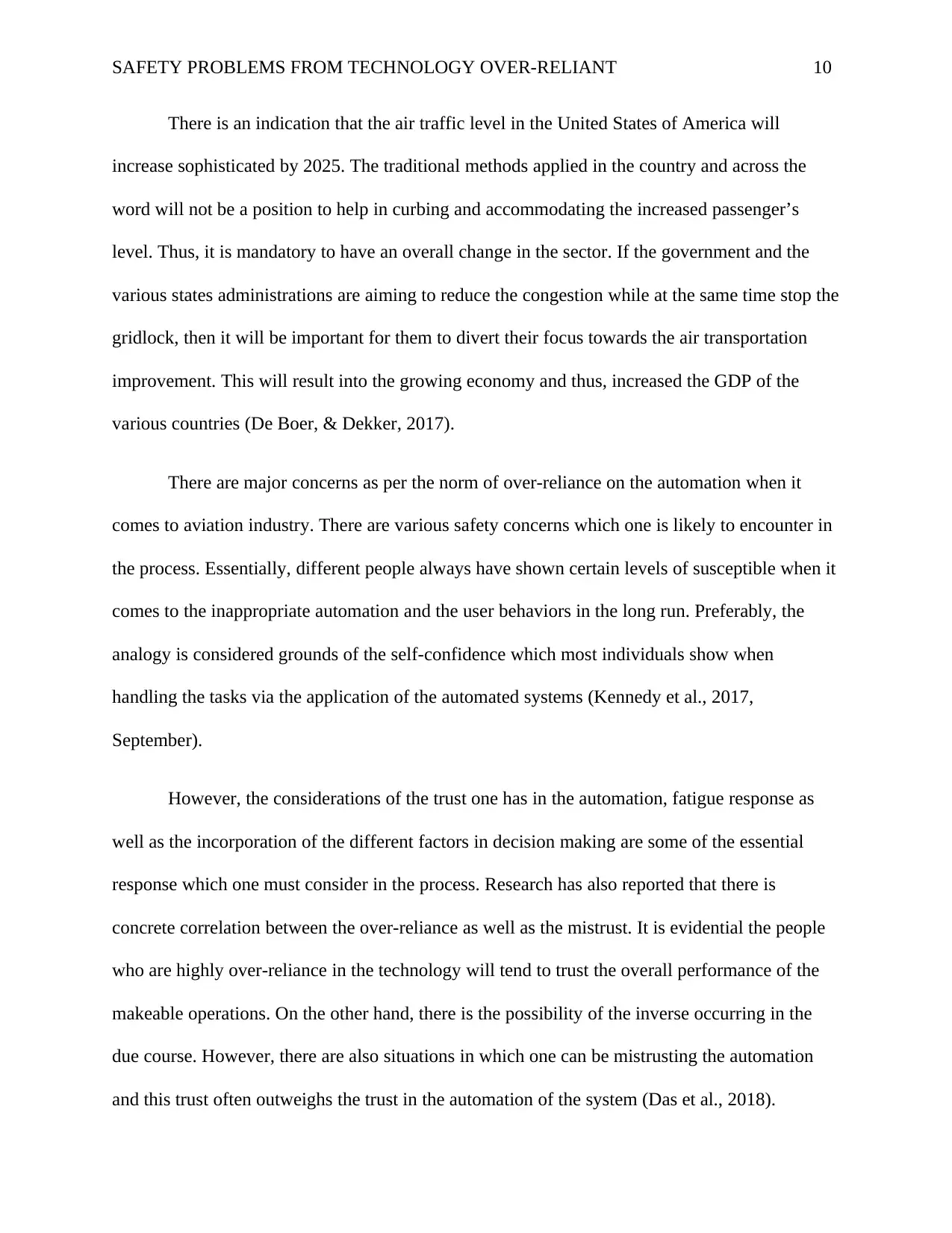
SAFETY PROBLEMS FROM TECHNOLOGY OVER-RELIANT 10
There is an indication that the air traffic level in the United States of America will
increase sophisticated by 2025. The traditional methods applied in the country and across the
word will not be a position to help in curbing and accommodating the increased passenger’s
level. Thus, it is mandatory to have an overall change in the sector. If the government and the
various states administrations are aiming to reduce the congestion while at the same time stop the
gridlock, then it will be important for them to divert their focus towards the air transportation
improvement. This will result into the growing economy and thus, increased the GDP of the
various countries (De Boer, & Dekker, 2017).
There are major concerns as per the norm of over-reliance on the automation when it
comes to aviation industry. There are various safety concerns which one is likely to encounter in
the process. Essentially, different people always have shown certain levels of susceptible when it
comes to the inappropriate automation and the user behaviors in the long run. Preferably, the
analogy is considered grounds of the self-confidence which most individuals show when
handling the tasks via the application of the automated systems (Kennedy et al., 2017,
September).
However, the considerations of the trust one has in the automation, fatigue response as
well as the incorporation of the different factors in decision making are some of the essential
response which one must consider in the process. Research has also reported that there is
concrete correlation between the over-reliance as well as the mistrust. It is evidential the people
who are highly over-reliance in the technology will tend to trust the overall performance of the
makeable operations. On the other hand, there is the possibility of the inverse occurring in the
due course. However, there are also situations in which one can be mistrusting the automation
and this trust often outweighs the trust in the automation of the system (Das et al., 2018).
There is an indication that the air traffic level in the United States of America will
increase sophisticated by 2025. The traditional methods applied in the country and across the
word will not be a position to help in curbing and accommodating the increased passenger’s
level. Thus, it is mandatory to have an overall change in the sector. If the government and the
various states administrations are aiming to reduce the congestion while at the same time stop the
gridlock, then it will be important for them to divert their focus towards the air transportation
improvement. This will result into the growing economy and thus, increased the GDP of the
various countries (De Boer, & Dekker, 2017).
There are major concerns as per the norm of over-reliance on the automation when it
comes to aviation industry. There are various safety concerns which one is likely to encounter in
the process. Essentially, different people always have shown certain levels of susceptible when it
comes to the inappropriate automation and the user behaviors in the long run. Preferably, the
analogy is considered grounds of the self-confidence which most individuals show when
handling the tasks via the application of the automated systems (Kennedy et al., 2017,
September).
However, the considerations of the trust one has in the automation, fatigue response as
well as the incorporation of the different factors in decision making are some of the essential
response which one must consider in the process. Research has also reported that there is
concrete correlation between the over-reliance as well as the mistrust. It is evidential the people
who are highly over-reliance in the technology will tend to trust the overall performance of the
makeable operations. On the other hand, there is the possibility of the inverse occurring in the
due course. However, there are also situations in which one can be mistrusting the automation
and this trust often outweighs the trust in the automation of the system (Das et al., 2018).
Paraphrase This Document
Need a fresh take? Get an instant paraphrase of this document with our AI Paraphraser
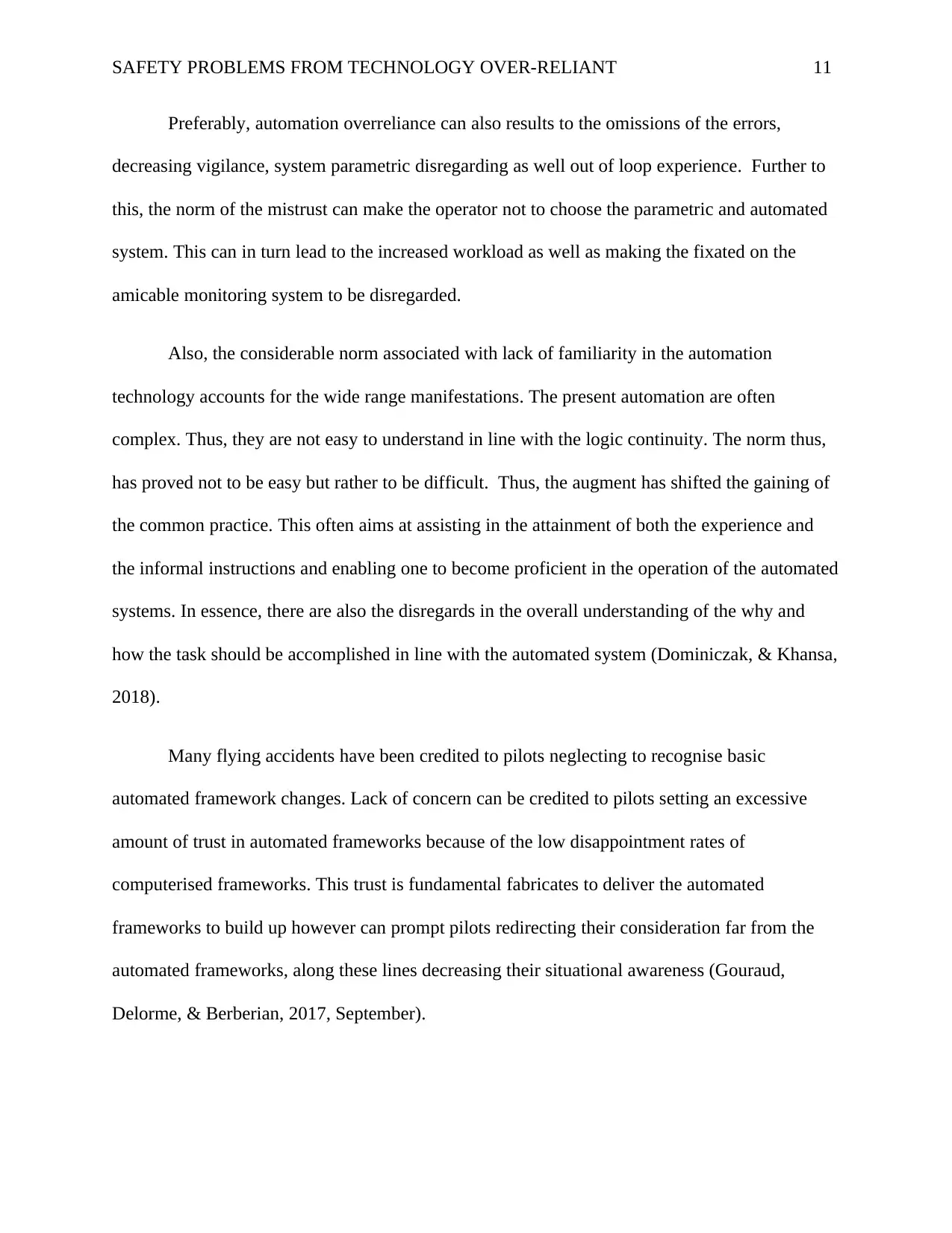
SAFETY PROBLEMS FROM TECHNOLOGY OVER-RELIANT 11
Preferably, automation overreliance can also results to the omissions of the errors,
decreasing vigilance, system parametric disregarding as well out of loop experience. Further to
this, the norm of the mistrust can make the operator not to choose the parametric and automated
system. This can in turn lead to the increased workload as well as making the fixated on the
amicable monitoring system to be disregarded.
Also, the considerable norm associated with lack of familiarity in the automation
technology accounts for the wide range manifestations. The present automation are often
complex. Thus, they are not easy to understand in line with the logic continuity. The norm thus,
has proved not to be easy but rather to be difficult. Thus, the augment has shifted the gaining of
the common practice. This often aims at assisting in the attainment of both the experience and
the informal instructions and enabling one to become proficient in the operation of the automated
systems. In essence, there are also the disregards in the overall understanding of the why and
how the task should be accomplished in line with the automated system (Dominiczak, & Khansa,
2018).
Many flying accidents have been credited to pilots neglecting to recognise basic
automated framework changes. Lack of concern can be credited to pilots setting an excessive
amount of trust in automated frameworks because of the low disappointment rates of
computerised frameworks. This trust is fundamental fabricates to deliver the automated
frameworks to build up however can prompt pilots redirecting their consideration far from the
automated frameworks, along these lines decreasing their situational awareness (Gouraud,
Delorme, & Berberian, 2017, September).
Preferably, automation overreliance can also results to the omissions of the errors,
decreasing vigilance, system parametric disregarding as well out of loop experience. Further to
this, the norm of the mistrust can make the operator not to choose the parametric and automated
system. This can in turn lead to the increased workload as well as making the fixated on the
amicable monitoring system to be disregarded.
Also, the considerable norm associated with lack of familiarity in the automation
technology accounts for the wide range manifestations. The present automation are often
complex. Thus, they are not easy to understand in line with the logic continuity. The norm thus,
has proved not to be easy but rather to be difficult. Thus, the augment has shifted the gaining of
the common practice. This often aims at assisting in the attainment of both the experience and
the informal instructions and enabling one to become proficient in the operation of the automated
systems. In essence, there are also the disregards in the overall understanding of the why and
how the task should be accomplished in line with the automated system (Dominiczak, & Khansa,
2018).
Many flying accidents have been credited to pilots neglecting to recognise basic
automated framework changes. Lack of concern can be credited to pilots setting an excessive
amount of trust in automated frameworks because of the low disappointment rates of
computerised frameworks. This trust is fundamental fabricates to deliver the automated
frameworks to build up however can prompt pilots redirecting their consideration far from the
automated frameworks, along these lines decreasing their situational awareness (Gouraud,
Delorme, & Berberian, 2017, September).
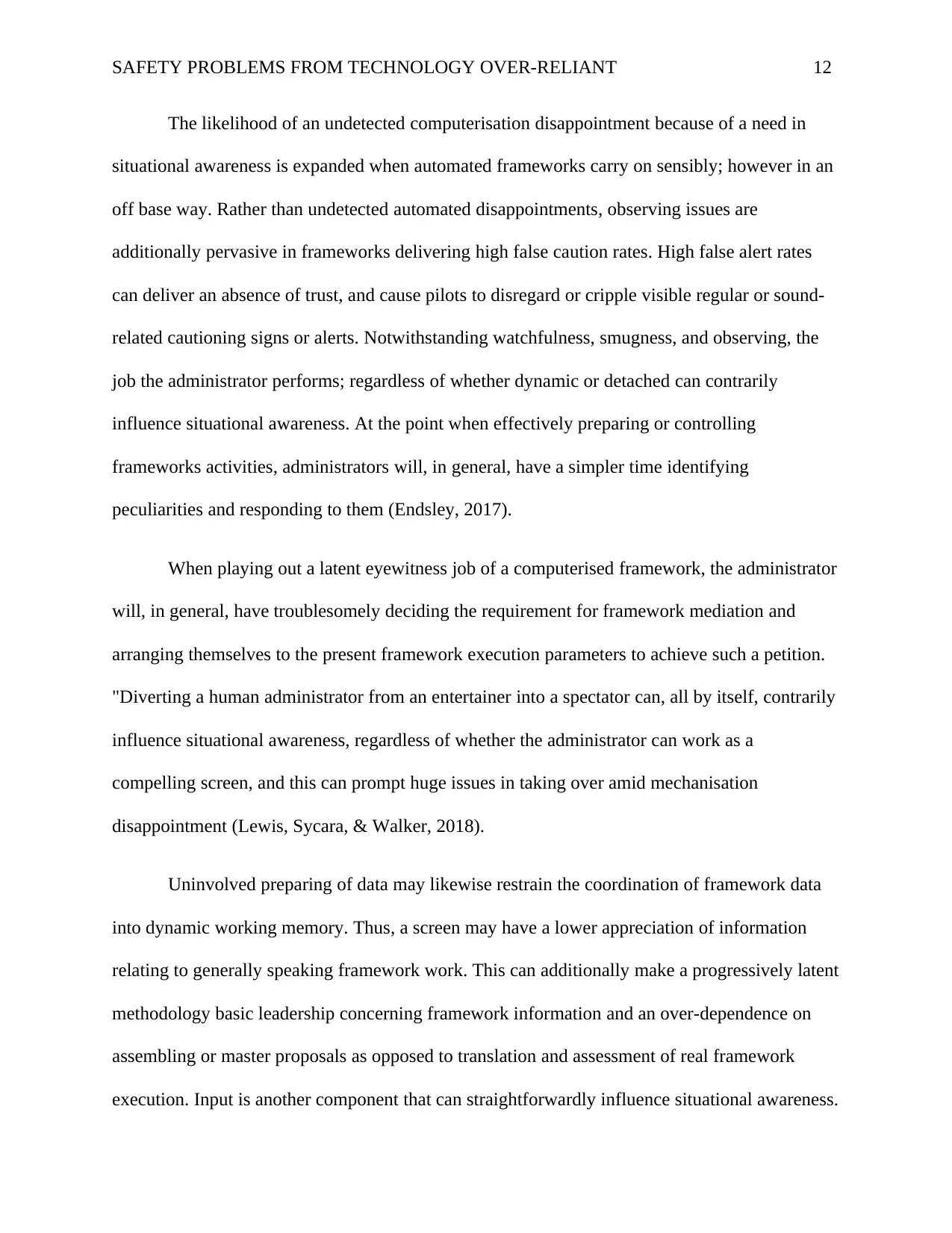
SAFETY PROBLEMS FROM TECHNOLOGY OVER-RELIANT 12
The likelihood of an undetected computerisation disappointment because of a need in
situational awareness is expanded when automated frameworks carry on sensibly; however in an
off base way. Rather than undetected automated disappointments, observing issues are
additionally pervasive in frameworks delivering high false caution rates. High false alert rates
can deliver an absence of trust, and cause pilots to disregard or cripple visible regular or sound-
related cautioning signs or alerts. Notwithstanding watchfulness, smugness, and observing, the
job the administrator performs; regardless of whether dynamic or detached can contrarily
influence situational awareness. At the point when effectively preparing or controlling
frameworks activities, administrators will, in general, have a simpler time identifying
peculiarities and responding to them (Endsley, 2017).
When playing out a latent eyewitness job of a computerised framework, the administrator
will, in general, have troublesomely deciding the requirement for framework mediation and
arranging themselves to the present framework execution parameters to achieve such a petition.
"Diverting a human administrator from an entertainer into a spectator can, all by itself, contrarily
influence situational awareness, regardless of whether the administrator can work as a
compelling screen, and this can prompt huge issues in taking over amid mechanisation
disappointment (Lewis, Sycara, & Walker, 2018).
Uninvolved preparing of data may likewise restrain the coordination of framework data
into dynamic working memory. Thus, a screen may have a lower appreciation of information
relating to generally speaking framework work. This can additionally make a progressively latent
methodology basic leadership concerning framework information and an over-dependence on
assembling or master proposals as opposed to translation and assessment of real framework
execution. Input is another component that can straightforwardly influence situational awareness.
The likelihood of an undetected computerisation disappointment because of a need in
situational awareness is expanded when automated frameworks carry on sensibly; however in an
off base way. Rather than undetected automated disappointments, observing issues are
additionally pervasive in frameworks delivering high false caution rates. High false alert rates
can deliver an absence of trust, and cause pilots to disregard or cripple visible regular or sound-
related cautioning signs or alerts. Notwithstanding watchfulness, smugness, and observing, the
job the administrator performs; regardless of whether dynamic or detached can contrarily
influence situational awareness. At the point when effectively preparing or controlling
frameworks activities, administrators will, in general, have a simpler time identifying
peculiarities and responding to them (Endsley, 2017).
When playing out a latent eyewitness job of a computerised framework, the administrator
will, in general, have troublesomely deciding the requirement for framework mediation and
arranging themselves to the present framework execution parameters to achieve such a petition.
"Diverting a human administrator from an entertainer into a spectator can, all by itself, contrarily
influence situational awareness, regardless of whether the administrator can work as a
compelling screen, and this can prompt huge issues in taking over amid mechanisation
disappointment (Lewis, Sycara, & Walker, 2018).
Uninvolved preparing of data may likewise restrain the coordination of framework data
into dynamic working memory. Thus, a screen may have a lower appreciation of information
relating to generally speaking framework work. This can additionally make a progressively latent
methodology basic leadership concerning framework information and an over-dependence on
assembling or master proposals as opposed to translation and assessment of real framework
execution. Input is another component that can straightforwardly influence situational awareness.
⊘ This is a preview!⊘
Do you want full access?
Subscribe today to unlock all pages.

Trusted by 1+ million students worldwide
1 out of 25
Related Documents
Your All-in-One AI-Powered Toolkit for Academic Success.
+13062052269
info@desklib.com
Available 24*7 on WhatsApp / Email
![[object Object]](/_next/static/media/star-bottom.7253800d.svg)
Unlock your academic potential
Copyright © 2020–2025 A2Z Services. All Rights Reserved. Developed and managed by ZUCOL.




